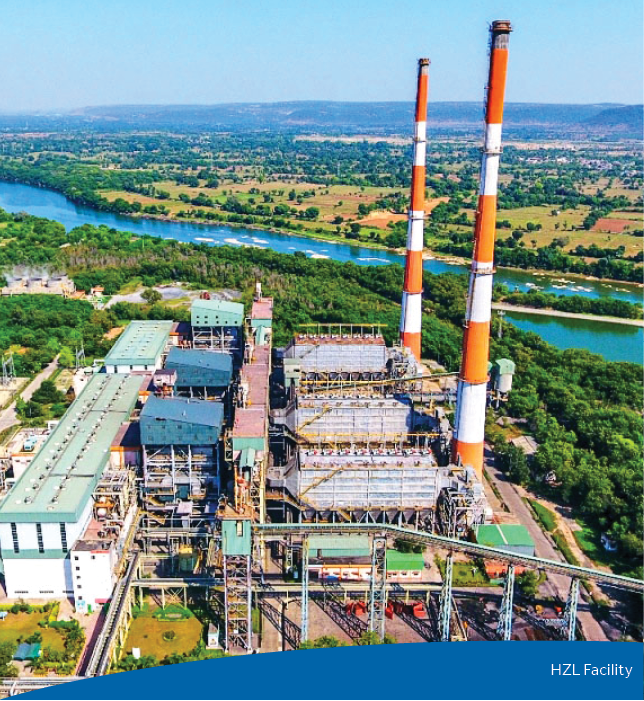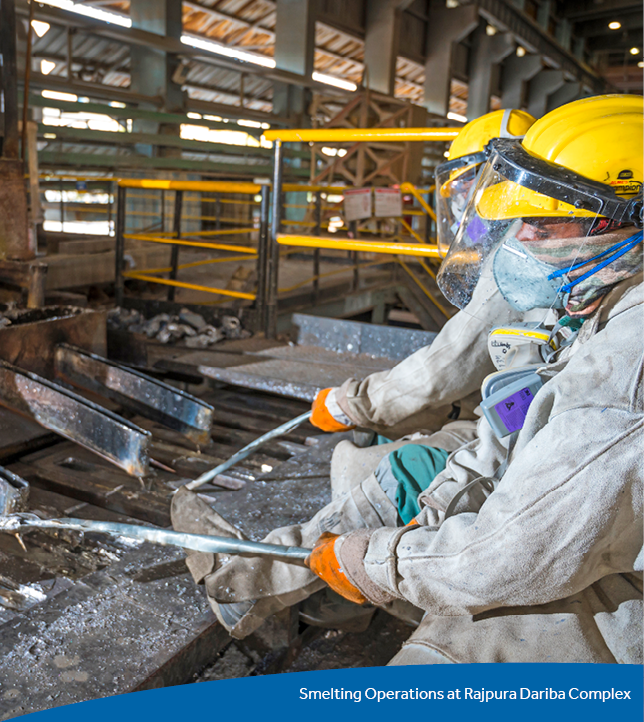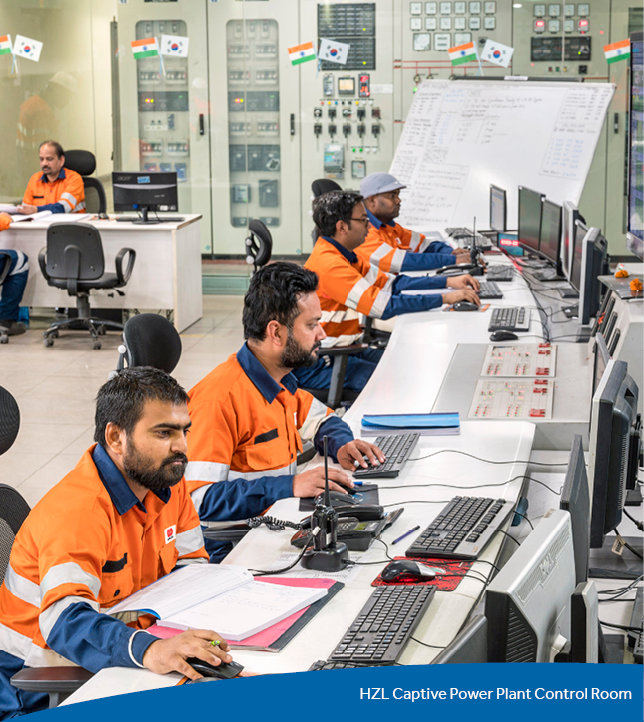THE YEAR IN BRIEF
Our mine production gradually improved during the year with ore production for the full year, up by 7% y-o-y, to deliver a record production of 15.5 million tonnes. This was supported by robust production growth at Zawar mines and Rampura Agucha mine, up by 21% and 9%, respectively. Our operations were halted on account of the pandemic-induced lockdown from 22 March 2020 onwards, impacting 3-4 weeks of equivalent production. Mined metal production was up by 6% y-o-y to 972 kt, primarily on account of higher ore production, with overall grades remaining at the same levels.
THE YEAR IN BRIEF
Our mine production gradually improved during the year with ore production for the full year, up by 7% y-o-y, to deliver a record production of 15.5 million tonnes. This was supported by robust production growth at Zawar mines and Rampura Agucha mine, up by 21% and 9%, respectively. Our operations were halted on account of the pandemic-induced lockdown from 22 March 2020 onwards, impacting 3-4 weeks of equivalent production. Mined metal production was up by 6% y-o-y to 972 kt, primarily on account of higher ore production, with overall grades remaining at the same levels.
OCCUPATIONAL HEALTH & SAFETY
Lost time injury frequency rate (LTIFR) for the last quarter was 0.92 vis-à-vis 1.23 in Q4FY21, driven by several safety awareness, investigation and prevention initiatives. Compared to a year ago, the number of LTIs declined from 18 to 13 in the fourth quarter. LTIFR for the year was 0.98 (total 51 LTIs). There has been greater management focus to bring a cultural shift via felt leadership programmes, safety town halls, enabling tools such as safety whistle-blower as well as reward and recognition for near-miss reporting.
In view of the COVID-19 health emergency, an advisory was issued for the precautionary measures, along with awareness campaigns and drive for disinfecting facilities across the Company. The Company’s operations were halted during the lockdown and employees were asked to work from home barring some employees, who attended call for duty to keep production assets safe. To ensure business continuity, a committee of COVID-19 Response ‘War Room’ was organised to identify and implement urgent business decisions. We also engaged the Self-Help Group (SHG) women in our communities to stitch and distribute cloth masks among the villagers, police and administration officials. Our teams also worked with the civil administration to ensure that food reached the vulnerable population.
During the year we commissioned an underground Occupational Health Centre at Rampura Agucha Mine which significantly improves the response time in emergency cases. Senior management visits to shop floors and Gemba walks at contractor operated sites reiterated the focus on felt leadership in the organisation. ‘Sameeksha’ was conducted with six business partners to discuss the details of their serious LTI with CEO, HZL chairing the session.
ENVIRONMENT
Zinc India was certified as 2.41x water positive company, defined as a ratio of Water Credit and Water Debit. The assessment was carried by DNV GL, a globally renowned risk management and quality assurance company. Initiatives like rainwater harvesting, recharge to ground water and use of treated sewage water have enabled us to achieve this distinction.
Zinc India management has finalised Sustainability Goals 2025 by undertaking the following targets:

Zinc India’s 22 MW solar power project at RAM was registered under the Gold Standard during the year. DSC Zinc successfully commissioned a 4,500 mtpa FPT (Freeze Precipitation Technology) plant to recover sodium sulphate from the final multi-stage RO rejects which will cater to 1/3rd of DSC Hydro smelter’s input salt requirements to support our circular economy goal. The CPP Team conducted an innovative in-house recycling of the bottom ash to convert it into fly ash (saleable product) improving value realisation and lowering the environment footprint. Zinc India’s Udaipur Sewage Treatment Plants expanded to 55 MLD, translating into over 90% treatment of the city’s sewage.
Zinc India led an endorsement for ‘UNGC (United Nations Global Compact) CEO Water Mandate’ giving our commitment towards water stewardship and initiating our journey to follow the six principles laid out by UNGC. As part of our commitment towards biodiversity conservation, the Company is now a member of IUCN ‘Leader for Nature India’ initiative. HZL actively participated in the 3rd meeting of ‘Business Leaders Group COP26’ and actively engaged in shaping the agenda for COP26, to be held at Glasgow (UK) in November 2021.
Our sustainability initiatives received several endorsements during the year including the selection in ‘Sustainability Yearbook 2021’ as Member for the fourth consecutive year, Supplier Engagement Rating ‘A’ received from CDP, first position in the Asia Pacific region in metal and mining sector in Dow Jones Sustainability Indices and 7th Globally and CII-ITC Corporate Excellence Sustainability Award 2020. Zinc India (HZL) was featured among the first Indian companies to be featured in CDP India Annual Report and was rated ‘A’ in Climate Change CDP 2020. Hindustan Zinc is the first company in India to respond to CDP’s Forests questionnaire.
PRODUCTION PERFORMANCE
| Production (kt) | FY2021 | FY2020 | % change |
|---|---|---|---|
| Total mined metal | 972 | 917 | 6 |
| Refinery metal production | 930 | 870 | 7 |
| Refined zinc – integrated | 715 | 688 | 4 |
| Refined lead – integrated1 | 214 | 182 | 18 |
| Production – silver (in tonnes)2 | 706 | 610 | 16 |
1. Excluding captive consumption of 6,424 tonnes in FY2021 vs. 7,088 tonnes in FY2020.
2. Excluding captive consumption of 34.6 tonnes in FY2021 vs. 36.7 tonnes in FY2020.
OPERATIONS
For the full-year, ore production was up 7% y-o-y to 15.5 million tonnes on account of strong production growth at Rampura Agucha and Zawar mines, which were up by 9% and 21% respectively. Zinc India’s mined metal production for FY2021 was 971,976 tonnes compared to 917,101 tonnes in the previous year in line with higher ore production.
For the full year, metal production was up 7% to 930 kt in line with higher MIC availability, while silver production strengthened by 16% to a record 706 mt in line with higher lead production and better grades at SK. These record numbers were delivered despite losing 3-4 weeks equivalent of production days in the year due to COVID induced disruptions.

PRICES
| Particulars | FY2021 | FY2020 | % change |
|---|---|---|---|
| Average zinc LME cash settlement prices US$ per tonne | 2,422 | 2,402 | 1 |
| Average lead LME cash settlement prices US$ per tonne | 1,868 | 1,952 | (4) |
| Average silver prices US$/ounce | 22.9 | 16.5 | 38 |
LME Zinc prices averaged US$2,750 per mt in Q4FY21, up 29% y-o-y and 5% q-o-q. Investor interests in base metals is set to be sustained with the roll out of vaccination programmes globally. The recovery in international trade has not been uniform. In comparison to December 2020, the bulk of the growth can be attributed to the growth of imports and exports in China and developed Asian nations. There was marginal growth from the European Union and the rest of Asia, and a modest decline for the US and UK. Wood Mackenzie estimates zinc LME prices to average US$2,800 per mt in 2021.
The ongoing vaccination programmes and relatively better manufacturing activity are providing positive cues to investors. As for the premiums in South East Asia, a combination of improving demand and smelters directing shipments to China have tightened the market, helping premiums to shift to the upper end of a US$90-110 per tonne range. Global exchange stocks ended at 389 kt in March, marginally higher than in February, but remain at 10 days in terms of days of global consumption.
ZINC DEMAND – SUPPLY
| Zinc Global Balance In kt | CY 2019 | CY 2020 | CY 2021 E |
|---|---|---|---|
| Mine Production | 13,363 | 12,491 | 13,171 |
| Smelter Production | 13,601 | 13,731 | 13,938 |
| Consumption | 13.924 | 13,228 | 13,755 |
Source: Wood Mackenzie, March STO
Last year, the largest supply changes were attributed to Chinese mines, primarily from Inner Mongolia, Hunan and Sichuan. This reflects the poor performance of the small mine sector, where several mines in these provinces failed to restart. Hunan was most affected. The 2021 global mine production estimate of Wood Mackenzie is 13.2 mt, a 5.47% increase vis-à-vis 2020. The Chinese spot TCs declined from US$85 in December to US$70 in March in favour of miners.
After hitting a low of 27.4 in April 2020, the manufacturing Purchasing Managers Index (PMI) hit 54.6 in September and has averaged 57 in the four months through to February 2021. This is pointing to a robust pace of expansion for the country’s manufacturing sector. The strength of the rebound in activity has driven a rapid recovery in the Indian steel production with crude steel production hitting 9.7 mt in December, its highest since the record high of just over 10 Mt in March 2019. With India’s economic growth entering positive territory, the strong performance of India’s steel sector seen in the latter part of 2020 should be sustained into 2021.

UNIT COSTS
| Particulars | FY2021 | FY2020 | % change |
|---|---|---|---|
| Unit costs (US$ per tonne) | |||
| Zinc(including royalty) | 1,286 | 1,371 | (6) |
| Zinc (excluding royalty) | 954 | 1,047 | (9) |
For the full year, zinc COP excluding royalty was US$954, lower by 9% y-o-y. The COP decrease reflects lower spend on consumables, lower coal and coke consumption, digitisation led operational efficiency, which was partly offset by higher R&M expense, other mining and manufacturing expenses.
FINANCIAL PERFORMANCE
(` crore, unless stated)
| Particulars | FY2021 | FY2020 | % change |
|---|---|---|---|
| Revenue | 21,932 | 18,159 | 21 |
| EBITDA | 11,620 | 8,714 | 33 |
| EBITDA margin (%) | 53% | 48% | - |
Revenue from operations for the year was `21,932 crore, up 21% y-o-y, primarily on account of higher metal production partly offset by lower sulphuric acid and lower domestic sales of zinc.
EBITDA in FY2021 increased to `11,620 crore, up 33% y-o-y. The increase was primarily driven by higher revenue and lower cost of production.
PROJECTS
We commissioned a 10 MLD STP plant in Udaipur and another 5 MLD STP (Sewage Treatment Plant) is in its last leg of commissioning, which will take the total STP capacity set up by us to 60 MLD. This will treat almost the entire sewage of Udaipur city and the recycled water will be used by our plants, significantly reducing our freshwater intake.
During the year, our graphite floatation system was commissioned at Mill 3 of Sindesar Khurd Mines, which will enhance the smelter throughput and bolster recovery.
During the quarter, backfill plants were commissioned at Zawarmala and Mochia mines. These plants will derisk operations and provide an opportunity to mine left-out high-grade ore in pillars. On similar lines, we have also commenced activities for a combined paste-fill and dry tailing plant at Rajpura Dariba. This will help increase ore production from 1.2 mtpa to 2 mtpa; also facilitating additional utilisation of tails by ~20% for back filling and will reduce stope turnaround time.

The development of North Decline (ND1) was completed at Rampura Agucha (RA) mine. This improves the accessibility of the shaft section, alternate emergency evacuation, ease in mine equipment deployment at lower mine levels, face charging with emulsion explosives, face drilling with long feed jumbo, and so on.
We have commenced operations in RKD circuit (component of overall Fumer project) to treat Raw Zinc Oxide (RZO). COVID-19 restrictions including stringent visa guidelines for Chinese nationals continued during the year, which resulted in delay in commissioning of Fumer plant at Chanderiya. We are following up with government authorities to find a solution. Two back-fill plants in Zawar were also commissioned during the year.
EXPLORATION
The Company has put in place an aggressive exploration programme focusing on delineating and upgrading Reserves and Resources (R&R) within its licence areas. Technology adoption and innovation play a key role in enhancing exploration success.
The Company’s deposits remain ‘open’ and exploration identified a number of new targets for mining leases with the potential to increase R&R over the next 12 months. Across all the sites, the Company increased its surface drilling to assist in upgrading resources to reserves.
In line with previous years, the mineral resource is reported on an exclusive basis to the Ore Reserve and all statements have been independently audited by SRK (UK).

Total Ore Reserves increased significantly from 114.7 million tonnes at the end of FY2020 to 150.3 million tonnes at the end of FY2021 due to heightened focus on resource to reserve conversion during the year. Exclusive Mineral Resource totalled 297.6 million tonnes. Total R&R increased to 448 million tonnes as we added more resource than that was consumed during the year.
Total contained metal in Ore Reserves is 9.16 million tonnes of zinc, 2.55 million tonnes of lead and 295.5 million ounces of silver and the Mineral Resource contains 14.9 million tonnes of zinc, 6.3 million tonnes of lead and 618.7 million ounces of silver. At current mining rates, the R&R underpins metal production for more than
25 years.
STRATEGIC PRIORITIES & OUTLOOK
Our primary objective remains to concentrate on enhancing overall output, cost efficiency of our operations and disciplined capital expenditure. While the current economic environment remains uncertain, our goals over the medium term are unchanged.
Our key strategic priorities include: